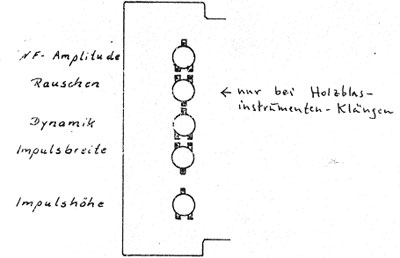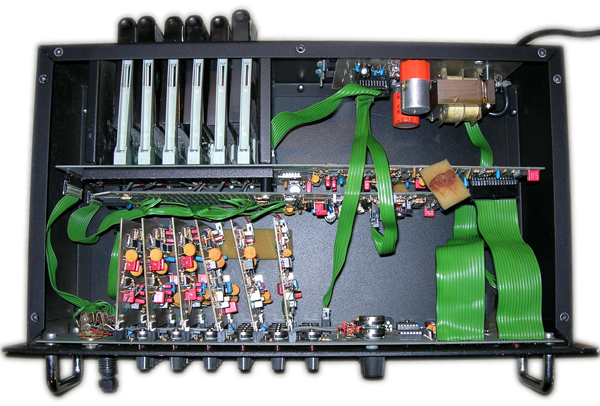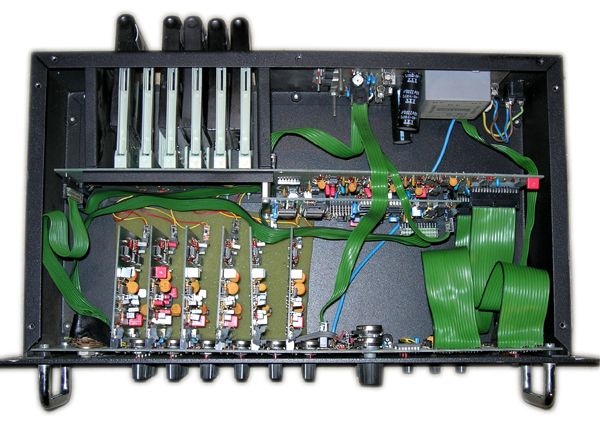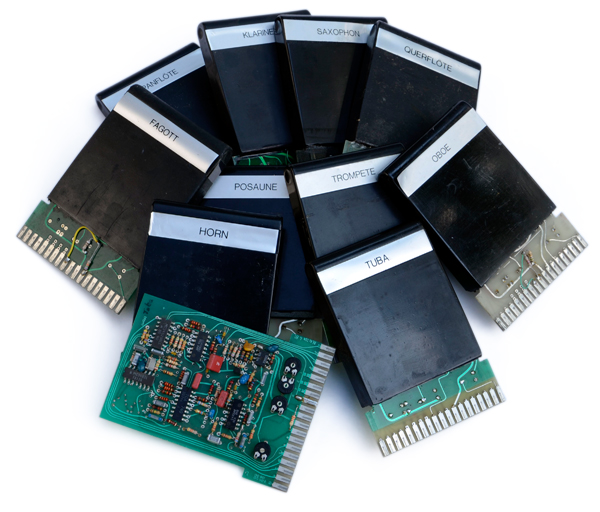In the sound processing unit (sometimes called "Music Cockpit") the controlling voltages of the blow controller and the keys are combined to influence the shape, width and heigth of a chain of electronic pulses. These pulses are modeled by the pulse forming functions of real wind instrument sounds ("Pulse Forming" or "real sound processing" (RSP).
Sound Processing Unit ("Music Cockpit") of the Variophon Standard
(old version)
Sound Processing Unit ("Music Cockpit") of the Variophon Standard
(new version)
For each timbre module there is only one timer IC as tone generator. A frequency divider determines the octave.
One could influence the timbre and the sound pressure of the sound generated by the pulse forming process without the help of filters, because the smallest change of the pulse shape and width resulted to an audible change of the spectrum (like in real wind instruments). Nevertheless, the Variophone gig had 4 potentiometers for each timbre to manipulate it in a broad range to never heard sounds:
- Upper Partials: for changing the amplitude of the high partials, (Sharpness of the sound),
- Lower Partials: for changing the amplitude of the low partials and the fundamental
- Formant Frequency: for selecting a spectral band which could be attenuated or amplified with the formant level potentiometer.
- Formant Level: for attenuating or amplifiing the choosen spectral band (formant frequency).
The sound processing unit had three (Martinetta), four (Variophon spot und standart) or six (Variophon gig) slots for the exchangeable timbre modules, which could be played solo or unisono in different combinations.
In the case of the Variophon gig the player could detune the different
voices infinitely variable, so he could play in parallels.
For the Variophon existed the following timbre modules:
- Oboe
- Bassoon
- Small Clarinet
- Clarinet
- Soprano Saxophon
- Alto saxophon
- Panflute
- French Horn
- Trumpet
- Trombone
- Tuba
You can try all these different sound colors in three dynamic degrees online at the virtuellen Variophon.
Because of the variation of the shape and width of the electronic pulses while playing the musician could modulate each tone like the tone of the original instrument.

Potentiometers on the Variophon
timbre module
With the help of the blow controller and the
pulse forming process all micromodulations
of the timbre were possible like playing with the real instrument. Also
the vibrato was a real timbre vibrato and not only a pure (poor) frequeny
or amplitude vibrato (like in normal electronical instruments).
The starting and decay transients and all
dynamic changes worked like the processes in real wind instruments, after
the principles of timbre, discovered by Karl Erich Schumann in the 1920ies.
One could tune the Martinetta in a C, B flat and D tune and the Variophon in a C, B flat and Es tune. Furthermore the Variophone had a small button for glissando playing.
Finally the pulse chain, formed by the blow controller and the selected pitch
goes to an amplifier (built-in in the case of the Martinetta and the Variophon
standard, external output in the case of the Variophon spot and Variophon
gig). The power supply happened over a normal wall socket (220 V) or in
some cases over a battery (9 V).

Variophon gig, older version (inside)

Variophon gig, newer version (inside)
